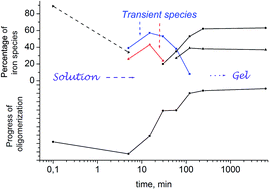Iron oxyhydroxide aerogels and xerogels were prepared by controlled hydrolysis of FeCl3·6H2O in organic solvents by using a limited amount of water or consuming solely water molecules available from the crystals. Ethanol, ethylene glycol, dimethyl sulfoxide (DMSO) and dimethyl formamide (DMFA) solvents were used, the hydrolysis was promoted with epichlorohydrin proton scavanger. High surface area aerogels were prepared by supercritical CO2 extraction of solvents, surface area and pore distribution measurements were performed on them. Aerogel and xerogel samples were characterized by XRD, Mössbauer spectroscopy and HRTEM methods. The process of hydrolysis was followed by recording Mössbauer spectra of frozen reaction mixtures. Stepwise progress and appearance of transient components were detected in DMSO and DMFA solvents. Aerogel samples exhibit asymmetric spectra with low probability of Mössbauer effect in their as synthesized state. In contrast, frozen reaction mixtures, gels, dry xerogels and compressed aerogels display symmetric spectra with high probability of the Mössbauer resonance. XRD proves the dominant presence of 2-line ferrihydrite. HRTEM studies reveal 4–8 nm typical particle sizes with 0.21–1.0 nm characteristic lattice distances. Different types of coordination environments are distinguished for iron in the formed ferrihydrite nanoparticles due to structural features and imperfections.

